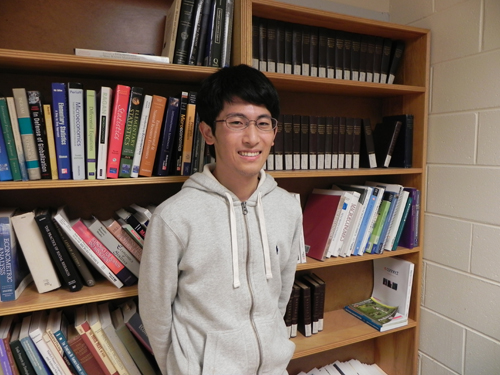Teaching assistants and tutorial options
The Department of Economics offers a number of senior economics students teaching assistant positions.
Tutorials significantly benefit both our senior and first-year students. They provide a unique opportunity for senior students to get experience in the classroom. This increases self-confidence, improves communication skills, develops interpersonal problem solving skills, and consolidates their knowledge of economics.
The system also benefits large numbers of first-year students who receive extra hours of instruction with our best senior economics students in small interactive class sessions. Moreover, because a senior student leads the sessions they offer another type of environment for students to ask questions and to play a more active role in their own learning experience.
Student research
Students specializing in economics enjoy opportunities to interact with faculty and to gain practical experience in research.
Each summer a number of students secure employment as research assistants or as summer research fellows. Course work plus practical paid experiences as a working economist assure our students have a significant advantage when choosing further studies or a long-term career.
Past summer research
Rosie Cockshutt
Rosie Cockshutt’s research looked at whether the difference in the cost of living between rural and urban areas affects the choice of women to work in these two areas. She found some interesting results, but not the ones she was looking for.
Read more
According to Cockshutt, women in rural areas tend to participate less in the labour force than women in urban areas. “We have known this for some time, but no one has figured out why it happens,” she says.
“There have been a lot of things proposed: the lack of demand for labour, preferences, and barriers to entry such as access to transport and childcare. None of them have been found to have a huge definitive effect,” says Cockshutt.
Cockshutt wondered whether the higher cost of living in urban areas made it necessary for urban women, who would normally not work, to enter the labour force in order to increase their family income.
“I used the introduction of the Working Income Tax Benefit (WITB), which is a tax benefit available to low-income individuals. I looked at the theory that women in rural areas should be more likely to enter the labour force with this benefit because it is more real income. They can purchase more with it than a similar woman in an urban environment.”
Eventually Cockshutt found that the introduction of the WITB does not have a significant effect on workforce participation. Although this was frustrating for Cockshutt, she did find something interesting in her study.
“No matter how you run the regressions, rural women with children under the age of six or children who aren’t in school, are always more likely to participate in the labour force than urban women with young children,” says Cockshutt. “This is cool because it goes against what previous literature suggested and what people generally assumed.”
Her research was supported by a Mount Allison University independent summer research grant.
Shin Yoshieda
"In the late 2000s, relations between China and Japan worsened. It was initially due to a territorial dispute over this one island. There were strong tensions. I was curious about how neighbouring countries reacted to this deterioration in the relationship and whether this had an effect on trade in the region."
Read more
“For example, did they take sides and refuse to trade with one or the other? So I looked at trade between Japan and China and countries in the Association of Southeast Asian Nations (ASEAN) — Indonesia, Malaysia, the Philippines, Singapore, Thailand, Brunei, Cambodia, Laos, Myanmar (Burma), and Vietnam.
"The research involved a statistical analysis of trade data to predict trade flows based on population, incomes, and distances and comparing actual and predicted trade flows to determine if there were “special” relationships. It certainly did not look like ASEAN countries took sides, not in an economic sense. It seems that ASEAN countries stayed pretty neutral. This is a good thing for the stabilization of the region that there is a strong third party in the region.”
Rebecca Dafoe
Rebecca Dafoe discovered a setback in research can actually turn out to be a good thing. Dafoe studied the determinants of indigenous mental health in Canada.
Read more
Dafoe originally intended to look at veterans’ mental health, but she was not able to get access to the data she needed in time to complete the project over the summer. So instead she looked at mood disorder, anxiety disorder, and self-reported mental health status. She also noticed something missing in the current models of indigenous health.
“The current models of indigenous health contained the standard set of determinants of health, income, employment status, environmental factors, like do you smoke, do you drink. But there were no determinants of the cultural side of health for indigenous people.”
Dafoe wanted to find cultural variables that reflected such things as the history of cultural suppression indigenous people face. She came up with three variables for residential schools: one if you went to a residential school, one if you had parents or grandparents who did, and one if you had parents and other family members who did.
“They showed me some interesting things. As you would expect, all these variables tended to increase the chance of reporting mood disorder, anxiety disorder, and decrease the chance of you reporting excellent mental health,” she said.
Dafoe also looked at indigenous languages and participation in traditional activities. When looked at in combination, having both of these variables resulted in better health outcomes.
“Basically what that tells me is that there appears to be something fundamentally important about these two variables in measuring health,” she says. “I tried to build a more culturally appropriate model of health rather than having a standard set of income and other variables applied to every population, indigenous or other. My approach allows me to examine the deeper causes of the health gap between indigenous and non-indigenous populations and to be more sensitive to the important differences between these groups."
Ian Nason
Honours economics student Ian Nason’s (’15) summer research project explored the reasons for the difference in the unemployment rate in the communities in Maine and New Brunswick on the US-Canada border. He received a Mount Allison University Summer Research Award to carry out his work.
Read more
“I am able to control for geography and culture because NB and Maine are so similar in terms of demographics, culture, and geography so any changes that are structural should just be due to differences in policies,” he says. “As for research, it can be a bit of a slog, but when you get over the hump and you find some cool things to talk about then it is very exciting.”





